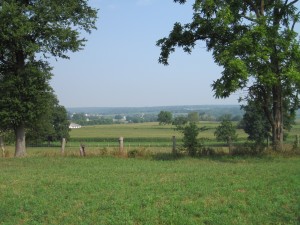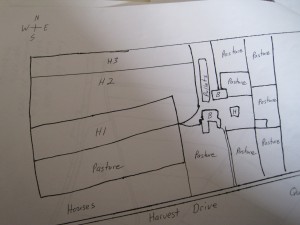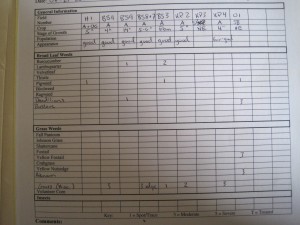I have a bit of back tracking to do in this first post. I have been working for a crop consultant in Lancaster county, PA since summer started. My first month or so working/interning was rather repetitious but rewarding. The first challenge I ran into was working around Cornell’s late spring schedule. Fortunately, Lancaster had a rather late spring this year due to all the rain but I still went home during study week which gave me a chance to get some preliminary training before planting season was in full swing. Once I was home for the summer my boss and I traveled around to farms together for the first week and then he sent me out on my own. May and June are pretty crazy months for crop consultants as all the corn (hopefully) is being planted and needs to be checked for weeds and overall health at least twice before it reaches 4 feet in height.
Essentially, this first month consisted of me working 12 hour days, driving around Lancaster county in my little Ford Ranger and walking through corn fields. During my week of training my boss showed me how to take corn populations and quizzed me on the different types of weeds and bugs/worms we were seeing in the fields. Taking corn populations is quite simple and I enjoyed learning to identify weeds. I’ve had to memorize about 15-20 common weed species, this includes both broad leaf weeds and grasses. The most challenging part of this was learning to differentiate between weeds in the seedling stage but after about a week on my own I felt pretty comfortable with the material.
I’ll give a quick overview of what an average day my first month looked like. My boss gave me several farm files each containing a map of all the fields farmed by a particular farmer and what was planted in those fields the past four years. I would then go to each corn field and walk through it in a sort of zig zag pattern. My main responsibility was to identify what weeds and/or bugs were present and how severe they were. I also observed the corn for any abnormalities but my boss usually double checked the quality of the corn. I then gave what I found to my boss and he wrote up a recommendation (usually pesticide recommendations) for the farmer.
The job can be a bit monotonous at times but there have been a few interesting cases that involved some agronomic forensics. For example, one of the farms I was at had 3 corn fields with some unusually purple colored corn in spots. I had seen purple tinted corn at other farms and was told that the coloration was due to stress and the variety of corn planted but this corn was a deeper purple than I had seen before. I let my boss know and he agreed that it didn’t look normal and some time later this corn was completely dead. It turned out that the business beside this farm had sprayed their gravel parking lot with a mixture designed to kill plants. Unfortunately, it rained shortly after the parking lot was sprayed and this mixture was washed into the cornfields, killing all the corn it came into contact with.
Things have calmed down a bit now that the corn has gotten too tall to apply pesticides. We’re now focusing more on alfalfa and soybeans but I’ll cover that in the next post.






Awesome first post Valerie! This gives us a terrific view into the world of crop consulting during the growing season. What classes have helped you the most? Can’t wait to read your next installment!